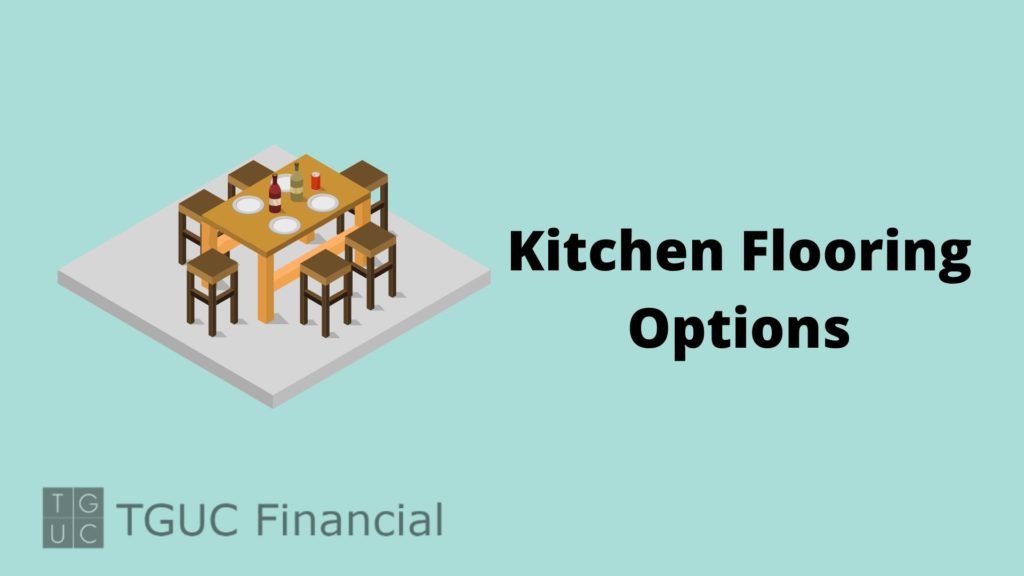
Whether you’re building a new kitchen or remodeling, which kitchen flooring to use is one of your biggest design decisions.
Choosing the material and design for your kitchen flooring has significant effects on the area’s overall look and mood. Besides aesthetics, your kitchen flooring also has to be durable and functional. If you’re trying to decide what kitchen flooring materials to invest in or what styles to follow, we have a list of 8 kitchen floor ideas to help you choose what’s best for you.
Kitchen Flooring Options

Hardwood
One of the most common materials for kitchen flooring is hardwood. Solid hardwood flooring elevates a kitchen’s design and can lend an elegant or rustic look to space, depending on the style you select. With a variety of stains and finishes to choose from, you can opt for rich, dark tones, natural wood finishes, or light stains that brighten the area.
However, using hardwood flooring in a kitchen can have several downsides. Wood floors can become stained or warped from moisture, which is common in the kitchen area. And the finish or surface of the wood planks will also wear down more quickly than other materials like stone or tile.
Hardwood floors tend to age gracefully, though, developing a patina from wear that many find beautiful and unique. The beauty pops out from the distinct grain of each hardwood panel. Maintaining this style of flooring is also fairly easy, especially when remodeling. You can sand or polish the floors again to refinish them, making them look brand new or changing the color to update the look.
How to Style It:
Achieve a full-blown regal look with hardwood floors and kitchen cabinets. An all-hardwood kitchen complements light kitchen walls to make space seem more expansive.
Stained hardwood floors also work well with light-colored base cabinets. Solid wood kitchen islands also tie the entire kitchen aesthetic together.
Bamboo
Bamboo as a kitchen flooring material is a recent rising trend, mostly due to its sustainability and eco-friendliness. Bamboo planks tend to be lighter in color and can brighten a kitchen instantly.
Even though bamboo isn’t technically wood (it’s a woody grass), bamboo floors tend to be sturdier and more rigid than some traditional hardwood floors, depending on the type of wood selected. They are also more resistant to water and spills when they are sealed properly.
Bamboo flooring is comparable in price to solid hardwood plank floors, and it has the added benefit of typically not requiring frequent touch-ups and repairs. Be sure to hire licensed contractors to install a bamboo floor. Working with bamboo material requires professional experience because it can be difficult to maneuver.
For DIY enthusiasts, bamboo flooring installation is out of the picture. Trust professionals on this one.
How to Style It:
Bamboo floorings provide a fresh look to any kitchen. Try pairing it with light greens and muted yellows on the walls. or the cabinets.
Neutral colors that complement the bamboo floor are also a good choice to complete the kitchen’s look. Finish the design by adding large glass windows to reflect light onto the flooring for a bright, airy kitchen you’ll enjoy being in.
Concrete
Another go-to kitchen flooring option is concrete. Although it may seem plain, concrete is a no-nonsense material ideal for ground-level kitchens and an inexpensive and long-lasting flooring option that’s especially perfect for those with limited budgets.
Its simple style may not suit everyone’s tastes, but unfinished or stained concrete flooring is rising in popularity among modern kitchens, especially those with an urban or industrial style. It leaves a raw yet sturdy look to the kitchen.
Additionally, concrete flooring comes in either polished or stained finishes.
How to Style It:
Regardless of whether it is polished or stained, concrete floors create an industrial vibe in the kitchen. Invest in steel surfaces for your kitchen cabinets and island, or stainless steel kitchen equipment, or mix metal finishes with iron, brass, and copper. The reflective glint of metal in the kitchen elevates the overall look, making it seem more sophisticated and chic, complementing the concrete flooring.
If you are partial to using steel materials, consider going for marble or quartz components for backsplashes or countertops. The beautiful patterns from these materials break the monotony of the concrete and add color and brightness to space.
Limestone
If you want to maintain a rough texture but don’t want to go with concrete flooring, limestone is your perfect match.
Limestone flooring is notable for the distinct uneven color palette that makes it stand out from other natural stone floors. Similar to concrete, limestone isn’t prone to wearing out. On top of that, it is easy to maintain and clean. When you wish to remodel the space, you only need to polish the limestone floors.
Another significant factor that sets limestone flooring apart is that it retains the room’s heat naturally. It doubles as a natural heating system that supports the household’s installed heating unit.
How to Style It:
Limestone floors work well with all-white kitchens. It fits with the bright color palette without overpowering other design elements. Additionally, the mixture of colors in each limestone tile adds dimension to the overall look.
Moreover, limestone flooring balances well with light-stained wooden kitchen cabinets. The visible grain of the wood goes well with the natural limestone design.
Tiles
Tiles are a go-to flooring material, in general. Kitchen or not, tile options are inexpensive and easy to clean. Tile flooring also lends itself to a DIY installation, even for those without prior experience.
Among the variety of tiles, ceramic, porcelain, and stone are the most preferred for kitchen flooring.
Ceramic
Ceramic tiles are water-resistant. Food and drink spills are easy to clean. Since it does not build up water, ceramic is more durable than other materials. Cleaning is also a breeze. You simply vacuum or sweep the floor then mop.
. If you want to remodel your kitchen with a limited budget, go for ceramic tiles. This affordable kitchen flooring option comes in a variety of sizes and designs that will suit any taste.
Porcelain
Porcelain tiles are denser and more water-resistant than ceramic tiles and are a preferred option when it comes to high-traffic areas like the kitchen.
Durable and scratch-resistant, porcelain tiles need little maintenance and are exceptionally strong. Upkeep is easy. Regular cleaning will make the area sanitary, food-safe, and beautiful.
How to Style It:
Regardless of the type of tile you choose, styling boils down to the choice of color, design, and size. Larger solid-colored tiles make the area look much more spacious. On the other hand, smaller brightly colored tiles add personality to your kitchen.
Eccentric designs in kitchens are getting more traction in modern kitchen layouts. For these designs, choose bold colors and patterns. This is a fun way to liven up space and add your personal touch.
Vinyl
Vinyl is a synthetic flooring material that is resistant to water and stains. It is made of several compound materials that make it flexible, shiny, and durable. You can choose to use vinyl sheets, tiles, or planks.
Sheet vinyl, in particular, is the easiest vinyl material to work with. It is the most flexible, making it easy to install. The long sheets of vinyl are pasted on the floor directly. They are easy to maneuver and adjust to accommodate straight or rounded corners. Vinyl tiles also glue down directly and are installed one at a time in a pattern.
On the other hand, engineered vinyl planks are interlocking strips that need to lock together when installed. Installing this material is more challenging than the vinyl sheets, but it is still possible without professional supervision. It just takes more time than a sheet or vinyl tiles.
How to Style It:
Vinyl flooring is notable for its wide selection of colors and patterns. If you choose a bold and colorful flooring pattern, try going with a single-toned kitchen to create a contrast.
Vinyl flooring also has designs that approximate the look of other materials, such as hardwood or tile. Think of this as an inexpensive and durable alternative to achieve your dream kitchen.
Linoleum
Something that sets linoleum flooring apart is that it’s antibacterial and antistatic. These factors alone make it a preferred flooring for commercial kitchens. It also makes it one of the top choices for modern kitchens. In fact, linoleum is one of the oldest materials used in kitchen flooring that is still popular today.
Aside from its practical benefits, linoleum also fares well in aesthetics. Linoleum, much like tiles, comes in different colors and designs. Current technology makes it possible to print intricate designs on the material to better suit your tastes.
How to Style It:
The difference between vinyl and linoleum flooring is a fine line. Imprints on vinyl flooring may fade or scuff over time. On the other hand, designs on linoleum are embedded. The pattern will not fade unless subjected to major damage, such as tears and holes.
Choose linoleum flooring colors that complement your kitchen cabinets. Using different shades of a single color to complete your kitchen is an easy way to go about it.
Cork
Cork flooring is a sustainable and comfortable kitchen flooring option. It is a durable material that holds up well to typical wear and tears.
Most people treat cork flooring as an entirely solid material, but that isn’t correct. Although cork is more durable than some flooring materials, it is malleable and susceptible to dents. The bottoms of heavy equipment, such as stoves and ovens, must be lined to avoid these dents and you should take care when dropping heavy items.
All in all, cork flooring is is durable, and water-resistant which is a plus, but it can also cause dirt to be trapped on the surface. Luckily, it’s also easy to clean and maintain.
How to Style It:
Cork floors traditionally come in beige and natural brown colors. With this in mind, it is easy to choose colors to complement it. With the neutral floor tones, don’t be afraid to try something bold.
The primary consideration when it comes to cork floors is the dents from heavier equipment. As a precaution, use a rug or another layer of coating to protect the flooring. You can choose a color that blends into the floor or something to show contrast.
Things to Consider When Remodeling Kitchen Flooring

No matter which kitchen flooring option you choose, they are all prone to damage and wear from constant use. Over time, remodeling is a must. Here are some factors to consider when remodeling kitchen floors, aside from choosing the flooring material.
Budget
Budget is always one of the main issues to consider with any remodeling project. The amount you are willing to shell out dictates the type of materials you can invest in. Deeper pockets mean you can fully remodel your kitchen floors and select high-end finishes such as hardwood planks or natural stone.
For those with more limited budgets, the abundance of flooring options provides several less expensive choices that are both durable and stylish. Tiles, linoleum, concrete, and vinyl floorings are some of the more affordable options.
Foot Traffic
You might have forgotten to consider this element when you first planned your kitchen. Kitchen flooring materials have different levels of durability when it comes to constant foot traffic. And as we all know, the kitchen is one of the busiest areas in the house.
When you remodel the kitchen, think about getting a material that can endure the most traffic. Cork and bamboo are two of the most durable materials. Vinyl, tiles, and linoleum are available options if you want to have durable floors that are easy to clean and colorful.
Kitchen Flooring Adaptability
If you’re the kind of kitchen owner who likes to change the colors of the space every so often, you might want to go for neutral-colored flooring.
A polished concrete finish works well with any colored kitchen cabinets and countertops. Hardwood floors also look good with both light and dark-themed kitchens.
Be sure you consider how flexible these floor materials are to avoid major changes. Kitchen remodeling needs more than just loose change so you don’t want to do it frequently.
Professional Kitchen Flooring Expertise
Lastly, when you are thinking about remodeling your kitchen, locate professionals that can help you with the process. Don’t jump in right away, no matter how eager you are for a change.
Get in touch with licensed contractors who are able to suggest designs and look for durable materials within your price points. They will also be responsible for locating skilled workers to complete the project and beautify your kitchen.
Don’t forget to discuss your plans with a designer. Interior designers, specifically, will provide options on how to maximize the kitchen’s layout. They will be responsible for correctly placing the equipment and selecting the ideal use of colors to make the kitchen your perfect working area.
Final Takeaways About Kitchen Flooring
The single-component that ties a kitchen design together is, believe it or not, the flooring. It is not the accent wall or kitchen island. Your kitchen flooring material and style link all the other design elements together. That’s why choosing the right kitchen flooring is such a big decision.
From wood to solid concrete, there are plenty of flooring options. Some are more heavy-duty than others, but they all have the same purpose. Of course, no flooring material is right for everyone. Each option appeals to certain people, so don’t worry about pleasing everyone with your design. Choose the material that best fits your use and creative direction.
Lastly, repairing and remodeling kitchen floors happens more often than you might think. Your kitchen floor bears the brunt of everyday wear and tear. So when you need to replace your kitchen flooring, don’t forget to consider these options and enjoy making your kitchen the beautiful and functional space it’s meant to be!
